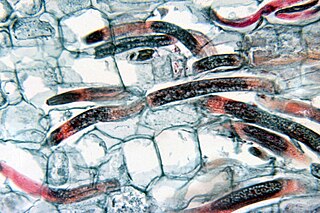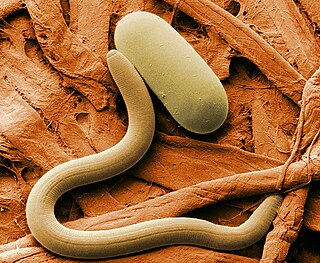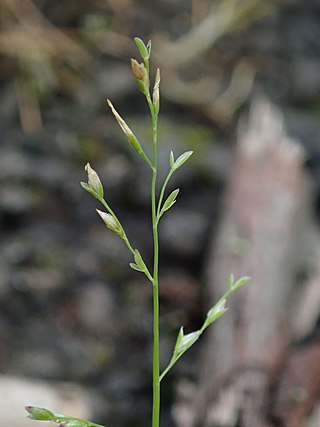
Poa pratensis, commonly known as Kentucky bluegrass, smooth meadow-grass, or common meadow-grass, is a perennial species of grass native to practically all of Europe, North Asia and the mountains of Algeria and Morocco. It is a common and incredibly popular lawn grass in North America with the species being spread over all of the cool, humid parts of the United States, despite the fact that it is not native to North America. The Spanish Empire brought the seeds of Kentucky bluegrass to the New World in mixtures with other grasses. In its native range, Poa pratensis forms a valuable pasture plant, characteristic of well-drained, fertile soil. It is also used for making lawns in parks and gardens and has established itself as a common invasive weed across cool moist temperate climates like the Pacific Northwest and the Northeastern United States. When found on native grasslands in Canada, for example, it is considered an unwelcome exotic plant, and is indicative of a disturbed and degraded landscape.
Northern root-knot nematode is a species of vegetable pathogens which produces tiny galls on around 550 crop and weed species. They invade root tissue after birth. Females are able to lay up to 1,000 eggs at a time in a large egg mass. By surviving harsh winters, they can survive in cold climates.

Radopholus similis is a species of nematode known commonly as the burrowing nematode. It is a parasite of plants, and it is a pest of many agricultural crops. It is an especially important pest of bananas, and it can be found on coconut, avocado, coffee, sugarcane, other grasses, and ornamentals. It is a migratory endoparasite of roots, causing lesions that form cankers. Infected plants experience malnutrition.

The soybean cyst nematode (SCN), Heterodera glycines, is the most devastating pest to soybean crop yields in the U.S., targeting the roots of soybean and other legume plants. When infection is severe SCNs cause stunting, yellowing, impaired canopy development, and yield loss. The symptoms caused by SCNs can go easily unrecognized by farmers—in some cases there are no warning symptoms before a loss of 40% of the yield. Due to the slight stunting and yellowing, many farmers may mistake these symptoms as environmental problems when in fact they are SCNs. Another symptom of SCNs that may affect farmers' yields is stunted roots with fewer nitrogen-fixing nodules. Due to the fact that soybean cyst nematodes can only move a few centimeters in the soil by themselves, they mostly are spread via tillage or plant transplants. This area of infection will look patchy and nonuniform making diagnosis more difficult for farmers. They can be seen in the roots of summer soybean plants if the roots are taken out very carefully and gently washed with water. The egg masses should be seen as bright white or yellow "pearls" on the roots. The later the roots are pulled the harder it will be to diagnose due to the SCNs female dying and turning a much darker color, forming a "cyst". The best way to know if a field is infected by soybean cyst nematodes is to take a soil sample to a nematologist.

Rotylenchulus reniformis, the reniform nematode, is a species of parasitic nematode of plants with a worldwide distribution in the tropical and subtropical regions.

Meloidogyne arenaria is a species of plant pathogenic nematodes. This nematode is also known as the peanut root knot nematode. The word "Meloidogyne" is derived from two Greek words that mean "apple-shaped" and "female". The peanut root knot nematode, M. arenaria is one of the "major" Meloidogyne species because of its worldwide economic importance. M. arenaria is a predominant nematode species in the United States attacking peanut in Alabama, Florida, Georgia, and Texas. The most damaging nematode species for peanut in the USA is M. arenaria race 1 and losses can exceed 50% in severely infested fields. Among the several Meloidogyne species that have been characterized, M. arenaria is the most variable both morphologically and cytologically. In 1949, two races of this nematode had been identified, race 1 which reproduces on peanut and race 2 which cannot do so. However, in a recent study, three races were described. López-Pérez et al (2011) had also studied populations of M. arenaria race 2, which reproduces on tomato plants carrying the Mi gene and race 3, which reproduces on both resistant pepper and tomato.

Meloidogyne javanica is a species of plant-pathogenic nematodes. It is one of the tropical root-knot nematodes and a major agricultural pest in many countries. It has many hosts. Meloidogyne javanica reproduces by obligatory mitotic parthenogenesis (apomixis).

Meloidogyne chitwoodi is a plant pathogenic root-knot nematode that is a crop pest of potatoes, carrots, and black salsify. Root-knot nematodes such as M. chitwoodi cause the production of root-knot galls when their larvae infect the plant's roots and capture nutrients stored in the roots.

Pratylenchus penetrans is a species of nematode in the genus Pratylenchus, the lesion nematodes. It occurs in temperate regions worldwide, regions between the subtropics and the polar circles. It is an animal that inhabits the roots of a wide variety of plants and results in necrotic lesions on the roots. Symptoms of P. penetrans make it hard to distinguish from other plant pathogens; only an assay of soil can conclusively diagnose a nematode problem in the field. P. penetrans is physically very similar to other nematode species, but is characterized by its highly distinctive mouthpiece. P. penetrans uses its highly modified mouth organs to rupture the outer surface of subterranean plant root structures. It will then enter into the root interior and feed on the plant tissue inside. P. penetrans is considered to be a crop parasite and farmers will often treat their soil with various pesticides in an attempt to eliminate the damage caused by an infestation. In doing this, farmers will also eliminate many of the beneficial soil fauna, which will lead to an overall degradation of soil quality in the future. Alternative, more environmentally sustainable methods to control P. penetrans populations may be possible in certain regions.
Xiphinema diversicaudatum is an amphimictic ectoparasitic nematode species. This species has a characteristically long stylet capable of penetrating into a host's vascular tissue. They have a wide host range with some of the extensively studied ones being strawberry, hops and raspberry, due to their economic importance. The direct root damage caused through penetration near the root tip and formation of galls is a secondary concern when compared with the damage caused by vectoring the Arabis mosaic virus. The virus attaches to the interior cuticle lining and can be transferred from infected to uninfected root tissue as the nematode feeds and sheds. Management of this particular nematode relies on nematicides such as 1,3-Dichloropropene (Telone) at 40 gpa.or methyl bromide at 1000 lb/ac to control to 28 in deep.
Subanguina wevelli is a plant pathogenic nematode and an invasive species.

Anguina agrostis is a plant pathogenic nematode.

Anguina is a genus of plant pathogenic nematodes.
Leifsonia is a Gram-positive genus of bacteria from the family Microbacteriaceae.

Poa infirma is a species of grass known by the common names early meadow-grass and weak bluegrass. It was first described from a specimen found in Colombia, but it is actually an introduced species in the Americas and is native to Europe. It grows in many types of habitat, including disturbed areas. It is very similar to Poa annua, which is probably a daughter species, and it is often mistaken for P. annua unless it is closely examined.

Root-gall nematodes are plant-parasitic nematodes from the genus Subanguina that affect grasses, including cereals, and some other plants, such as mugwort. They are distinct from the Root-knot nematodes which are from the genus Meloidogyne. So far around twenty-five separate species of Subanguina have been identified, although the most well-known and type species is Subanguina radicicola.
Leifsonia xyli is a Gram-positive species of bacteria from the family Microbacteriaceae.

California is the largest grower of peaches in the United States, producing about 70% of the total.











